| |

The Reggia of Caserta:
a treasure to discover
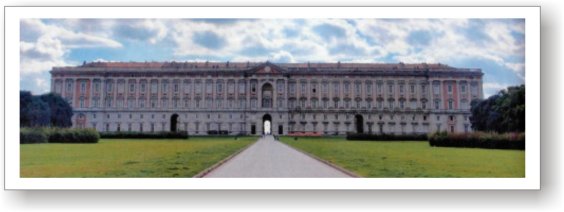
This fascinating historical palace belonged to
the Royal family of the Borbone dynasty of Naples and it was
built by the will of Carlo III, King of Naples, who not having
his own dwelling and, since thought that his family above all
needed tranquillity and moreover healthy air, decided to
realize the Reggia of Caserta. Not having a Royal palace, he
built his old dream: “to construct a palace similar to that of
Versailles”; however more majestic.
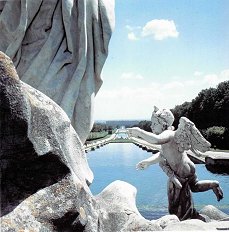 Besides finding itself in one of the most
beautiful plains in Italy, the Reggia of Caserta is encircled by
an immense park, in which the most beautiful waterfalls can be
seen, the charming fountains and gardens, of which are based on
English and French models. This Garden is adorned by statues,
created by the greatest partenopei sculptors, guided by Carlo
Vanvitelli. The Park, one of the most visited monuments in
Italy, represents the greatest attraction of the reggia. It
extends on a surface of one hundred and twenty hecters, for a
length of three kilometers, and is famous, above all, for the
Fountains and cascades. Behind the striking and showy facade,
the little park hides some unknown curiosities: the Caves, humid
and fresh also in summer, are opened behind some Fountains, in
particular that of Eolo, where the light penetrates through the
water. The immense park is divided, then, in two fields, the
“The Italian Garden” and the “The English Garden”. Besides finding itself in one of the most
beautiful plains in Italy, the Reggia of Caserta is encircled by
an immense park, in which the most beautiful waterfalls can be
seen, the charming fountains and gardens, of which are based on
English and French models. This Garden is adorned by statues,
created by the greatest partenopei sculptors, guided by Carlo
Vanvitelli. The Park, one of the most visited monuments in
Italy, represents the greatest attraction of the reggia. It
extends on a surface of one hundred and twenty hecters, for a
length of three kilometers, and is famous, above all, for the
Fountains and cascades. Behind the striking and showy facade,
the little park hides some unknown curiosities: the Caves, humid
and fresh also in summer, are opened behind some Fountains, in
particular that of Eolo, where the light penetrates through the
water. The immense park is divided, then, in two fields, the
“The Italian Garden” and the “The English Garden”.
The area of the Italian Garden extends to the
Island of the Fish farm, in which the fish were destined to the
Royal kitchens; a little distant the “Castelluccia”, a kind of
miniature fortress built up in 1769 for entertainment. Around
the rich and majestic park the so-called English Garden can be
seen, known as Garden Landscape. This was restored on the idea
of the garden in England by William Kent. Today, in the garden
the visitors of the Reggia can carefully notice innumerable
plants and flowers, which alternate from a small green wood, a
small lake, cascades, greenhouses for exotic plants, tall
cypresses and white statutes placed in the vegetation.
Moreover, a series of Fountains and works of
illustrious architects and sculptures. The Fountains for their
majesty were considered leading works of art and contributed to
the notoriety of the Reggia of Caserta.
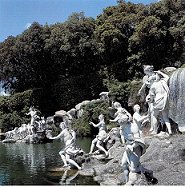 The first one is the Fountain of Margherita, from
which the tree-lined avenues begin penetrating into the forest;
it then follows Fontana of the Dolphins, whose water comes from
the mouths of gigantic dolphins; then the Fountain of Eolo,
embellished by 28 statues; ahead the Fountain of Cenere, which
forms seven small waterfalls and the majestic statues spray the
water in the air. To close the series of Fountains, before the
Great cascade is the Fountain of Venere and Adone: a huge marble
group where Venere is intent on dissuading Adone to go hunting
in order to avoid that him being killed by a wild boar.Around
the protagonists: nymphs, dogs, children and cupids. The first one is the Fountain of Margherita, from
which the tree-lined avenues begin penetrating into the forest;
it then follows Fontana of the Dolphins, whose water comes from
the mouths of gigantic dolphins; then the Fountain of Eolo,
embellished by 28 statues; ahead the Fountain of Cenere, which
forms seven small waterfalls and the majestic statues spray the
water in the air. To close the series of Fountains, before the
Great cascade is the Fountain of Venere and Adone: a huge marble
group where Venere is intent on dissuading Adone to go hunting
in order to avoid that him being killed by a wild boar.Around
the protagonists: nymphs, dogs, children and cupids.
Inside the Reggia it’s possible to visit
beautiful rooms. Within the 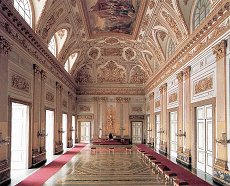 lounges open to the public, the more
important one is surely The Throne Lounge , the place where the
King officially received and where the court dances were held;
the astounding Lounge of Alessandro guards, instead, a fresco
that represents the Wedding of Alessandro and Rossana;
there is, moreover, the Lounge of Marte destined to the
Officials and the Soldiers, with reliefs of divinity and heroes,
in the centre part and trophies of the Victories and the war
Virtues represented by the symbols of Precaution and Force. The Lounge of Consiglio, The Lounge of Astrea, the Rooms of
Francesco II and those of Murat, the Library and the art
gallery, which accommodates the portraits of the King and the
Queens of the family of the Borbone, of Italy and or France. lounges open to the public, the more
important one is surely The Throne Lounge , the place where the
King officially received and where the court dances were held;
the astounding Lounge of Alessandro guards, instead, a fresco
that represents the Wedding of Alessandro and Rossana;
there is, moreover, the Lounge of Marte destined to the
Officials and the Soldiers, with reliefs of divinity and heroes,
in the centre part and trophies of the Victories and the war
Virtues represented by the symbols of Precaution and Force. The Lounge of Consiglio, The Lounge of Astrea, the Rooms of
Francesco II and those of Murat, the Library and the art
gallery, which accommodates the portraits of the King and the
Queens of the family of the Borbone, of Italy and or France.
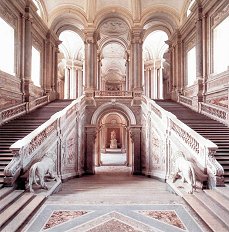
The Reggia of Caserta is one of the most immense
and majestic buildings in Italy and surely is one of the most
beautiful royal representations in the world. A charming Palace
that offers to the visitors a wide historical background in a
rich territory of culture, archaeology and art, accompanied by a
favorable geographic position, a moderate climate and amazing
nature, that render this structure a reference of beauties and
natural and historical resources.
- Torna al sommario -
|